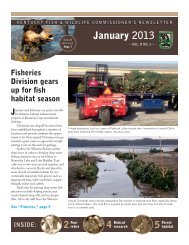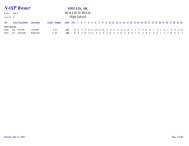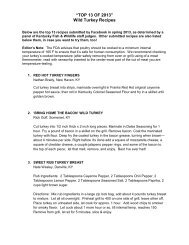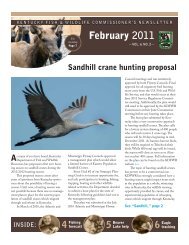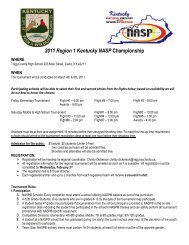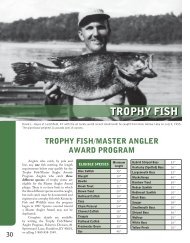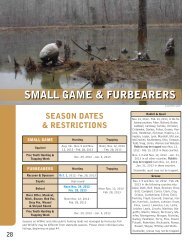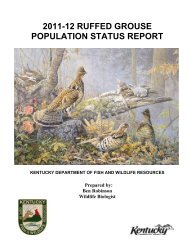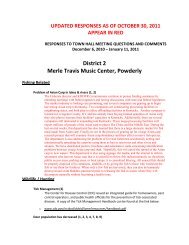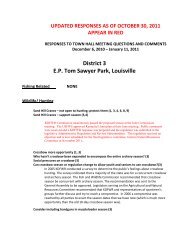Fescue Eradication - Kentucky Department of Fish and Wildlife ...
Fescue Eradication - Kentucky Department of Fish and Wildlife ...
Fescue Eradication - Kentucky Department of Fish and Wildlife ...
Create successful ePaper yourself
Turn your PDF publications into a flip-book with our unique Google optimized e-Paper software.
<strong>Fescue</strong><br />
<strong>Eradication</strong><br />
The number one problem on many farms today for<br />
ground nesting <strong>and</strong> ground-feeding wildlife species is the<br />
predominance <strong>of</strong> tall fescue (Figure 1). <strong>Fescue</strong> is simply a poor<br />
choice for wildlife habitat. KY 31 tall fescue is an extremely<br />
competitive plant, which tends to totally dominate fields<br />
where it has been established. Tall fescue is a sod-forming turf<br />
grass with a thick, matted growth form, which is extremely<br />
limiting to the movement <strong>of</strong> wildlife such as quail <strong>and</strong> rabbits.<br />
This thick growth <strong>of</strong>ten eliminates all other species <strong>of</strong> plants<br />
from growing, creating nearly monocultural fields <strong>of</strong> fescue.<br />
These virtually pure st<strong>and</strong>s <strong>of</strong> fescue lack the necessary diversity<br />
to provide the habitat components essential for supporting<br />
a variety <strong>of</strong> wildlife species. In the winter, fescue is flattened<br />
by the weight <strong>of</strong> snow <strong>and</strong> ice, therefore providing little or no<br />
winter cover.<br />
Nearly all st<strong>and</strong>s <strong>of</strong> KY 31 tall<br />
fescue are also infected with a fungus<br />
that lives in a mutually beneficial relationship<br />
with the fescue. The fungus<br />
produces chemicals in the plant, which<br />
cause fescue to have toxic qualities.<br />
These chemicals act as a feeding deterrent,<br />
causing animals not to eat the<br />
fescue, except as a last resort. By deterring<br />
feeding, the fungus, called an<br />
“endophyte”, has ensured a place for<br />
itself to live while in turn helping the<br />
fescue compete with other grasses <strong>and</strong><br />
forbs (broadleaf plants).<br />
There have been numerous<br />
studies in recent years documenting the<br />
effects <strong>of</strong> endophyte-infected tall fescue<br />
diets on a wide variety <strong>of</strong> animal species.<br />
This research has shown that a diet <strong>of</strong><br />
endophyte-infected fescue causes fescue<br />
toxicosis or “summer slump” in livestock.<br />
Effects include excessive body<br />
temperatures, elevated respiratory rates,<br />
loss <strong>of</strong> appetites, reductions in weight<br />
gain, lowered milk production, lowered<br />
fertility, <strong>and</strong> absorption <strong>of</strong> fetuses.<br />
Physical signs are cattle st<strong>and</strong>ing in<br />
ponds <strong>and</strong> creeks during summer<br />
months. Estimates <strong>of</strong> the loss to the<br />
livestock industry are over $500 million<br />
annually.<br />
In lab animals endophyteinfected<br />
diets have caused lowered<br />
sperm counts, lowered egg production,<br />
weight losses, abortion <strong>and</strong> absorption<br />
<strong>of</strong> fetuses, poor lactation, smaller than<br />
normal litter sizes, <strong>and</strong> slow or stunted<br />
Figure 1. <strong>Fescue</strong> dominates the l<strong>and</strong>scape across most<br />
<strong>of</strong> <strong>Kentucky</strong>’s farms.<br />
Habitat How-to’s
The #1 problem on<br />
many farms today<br />
for ground<br />
nesting <strong>and</strong><br />
ground-feeding<br />
wildlife species is<br />
the predominance<br />
<strong>of</strong> tall fescue.<br />
45 per cent <strong>of</strong> quail<br />
fed a diet <strong>of</strong><br />
entirely infected<br />
fescue seed died.<br />
Estimates to the loss<br />
<strong>of</strong> the livestock<br />
industry are over<br />
$500 million<br />
annually.<br />
development <strong>of</strong> young that were born. All <strong>of</strong> these result in<br />
lower production rates for animals. In a University <strong>of</strong> <strong>Kentucky</strong><br />
study quail were fed a diet <strong>of</strong> only infected fescue seed.<br />
45 percent <strong>of</strong> the birds died in the 12 day experiment.<br />
To greatly improve farms for small game populations,<br />
as well as increase the productivity <strong>and</strong> efficiency <strong>of</strong> livestock<br />
forage systems, it is recommend that efforts be made to eradicate<br />
most <strong>of</strong> the KY 31 <strong>Fescue</strong> in fields <strong>and</strong> replace it with<br />
other cool season grass/legume mixtures * <strong>and</strong> native warm<br />
season grass/forb mixtures. * Improved hay <strong>and</strong> pasture field<br />
systems will make farms more compatible with wildlife while<br />
also providing fresh, succulent pasture throughout the growing<br />
season.<br />
Killing <strong>Fescue</strong><br />
Eliminating fescue can be accomplished in a variety <strong>of</strong><br />
ways. The two primary methods <strong>of</strong> killing fescue are the use<br />
<strong>of</strong> herbicides <strong>and</strong> conventional tillage. The best results are<br />
achieved from a combination <strong>of</strong> treatments done over several<br />
years.<br />
Use <strong>of</strong> Herbicides<br />
No-till fescue eradication (using herbicides rather than<br />
actually breaking ground by plowing or tilling) is suitable for<br />
any area, but it is strongly recommended on any slopes with<br />
high erosion potential. The advantages <strong>of</strong> spraying include<br />
less time from the l<strong>and</strong>owner <strong>and</strong> minimal problems with soil<br />
erosion. The l<strong>and</strong>owner makes one pass with a spray rig<br />
rather than plowing, changing implements <strong>and</strong> disking or<br />
making several passes with a tiller to prepare a seedbed. Since<br />
you are not turning over ground soil erosion is limited. If you<br />
do not have spray equipment, you can contract with a local<br />
farm store or a local farmer to have the spraying done. Lowvolume<br />
spraying enables you to use fewer chemicals to<br />
achieve good coverage. High-pressure sprayers <strong>and</strong> flat fan<br />
nozzles allow as little as 10 gallons <strong>of</strong> solution per acre to be<br />
used (Tables 1 & 2 show spray rates <strong>of</strong> commonly used herbicides.)<br />
With herbicide treatments, timing <strong>of</strong> application is<br />
critical. <strong>Fescue</strong> should be sprayed when it is actively growing<br />
(late March-late April or mid-September to mid-October) <strong>and</strong><br />
about 8-12 inches tall. To prepare for herbicide treatment the<br />
fescue should first be grazed, mowed, or burned <strong>and</strong> allowed<br />
to re-grow to a height <strong>of</strong> 8-12 inches. On pasture or hayl<strong>and</strong>,<br />
simply remove livestock or cut 2-4 weeks prior to spraying to<br />
insure active growth. On fields that have been fallow, it will<br />
be necessary to mow 2-4 weeks prior to spraying to accomplish<br />
this. Burning * can be used instead <strong>of</strong> mowing with<br />
better results, but requires 3-6 weeks before enough re-growth<br />
has occurred for spraying (Caution: Never attempt to burn<br />
an area without consulting your area <strong>Kentucky</strong> <strong>Department</strong><br />
<strong>of</strong> <strong>Fish</strong> <strong>and</strong> <strong>Wildlife</strong> biologist to receive proper planning<br />
<strong>and</strong> assistance. <strong>Kentucky</strong> has burning laws which restrict<br />
time <strong>of</strong> day <strong>and</strong> proximity to woodl<strong>and</strong>s in which burning is<br />
legal. Contact the <strong>Kentucky</strong> Division <strong>of</strong> Forestry at (800)<br />
866-0555 for burning laws <strong>and</strong> bans in your area.) Avoid<br />
spraying in dry conditions when fescue growth has been<br />
slowed.<br />
It may be necessary to spot-spray some areas where<br />
fescue may have been missed. Spot spraying should be done<br />
2-6 weeks after the initial treatment, depending on the herbi<br />
cide used. Follow up eradication with one <strong>of</strong> the practices<br />
mentioned below. *
Spray Rates <strong>of</strong> Commonly Used Herbicides<br />
Table1. Table 2.<br />
Glyphosate (Roundup® or equivalent) herbicide Imidazoline (Plateau® or equivalent) herbicide<br />
Fall Application<br />
Fall Application<br />
2 quart/acre glyphosate Apply imidazoline at 8-12 oz. + 2 pints <strong>of</strong><br />
6-7 ounces <strong>of</strong> nonionic surfactant methylated seed oil (MSO) per acre<br />
Ammonium sulfate at 17 pounds/100<br />
Or a mix <strong>of</strong> 4-12 oz. imidazoline + 16-32oz.<br />
gallons <strong>of</strong> spray<br />
glyphosate + 2 pints MSO per acre<br />
10 gallons/acre water<br />
Apply with flat fan nozzles at 30-40 p.s.i.<br />
Spring Application<br />
Apply in fall when fescue is 6-12 inches<br />
Apply imidazoline at 8-12 oz. + 2 pints <strong>of</strong><br />
tall <strong>and</strong> actively growing<br />
MSO or<br />
Imidazoline at 4-12oz. + 16-64 oz.<br />
Spring Application<br />
glyphosate + 2 pints MSO per acre<br />
2 quarts/acre glyphosate<br />
6-7 ounces <strong>of</strong> nonionic surfactant Always refer to the manufacturer’s label<br />
Ammonium sulfate at 17 pounds/100<br />
for specific timing, rates <strong>and</strong> weeds<br />
gallons <strong>of</strong> spray<br />
controlled.<br />
10 gallons/acre water<br />
Apply with flat fan nozzles at 30-40 p.s.i.<br />
Apply in spring when most plants have<br />
reached boot to early seedhead stage<br />
Wait 7 days before preparing a seedbed<br />
for planting. Always refer to the manufacturer’s<br />
Note: Mention <strong>of</strong> tradenames does not<br />
constitute an endorsement <strong>of</strong> specific<br />
products. Consult your local farm supply<br />
store for availability <strong>of</strong> equivalent herbicides.<br />
label for specific timing, rates, <strong>and</strong> weeds controlled.<br />
Conventional Tillage<br />
On areas <strong>of</strong> little to no slope where the threat <strong>of</strong> soil<br />
erosion is not a concern, conventional tillage can be an effective<br />
means <strong>of</strong> eradicating fescue. This involves either fall or<br />
spring plowing <strong>and</strong> disking, or roto-tilling, to prepare a<br />
seedbed. It should be noted, however, that on areas where the<br />
threat <strong>of</strong> soil erosion is significant, conventional tillage should<br />
be avoided, or done on the contour with unplowed buffers left<br />
between tilled areas until the plowed strips have become<br />
adequately vegetated (six months to one year). If you have<br />
your own equipment plowing <strong>and</strong> disking, as opposed to<br />
spraying, require little out <strong>of</strong> pocket expense. Plowing <strong>and</strong><br />
disking also can be useful tools for generating valuable native<br />
vegetation that results from soil disturbance, such as foxtail,<br />
ragweed, annual lespedezas <strong>and</strong> partridge pea.<br />
Once a seedbed is prepared you have several options.<br />
One option would be to simply use a smother crop to suppress<br />
any fescue that may have survived tillage. A smother crop is a<br />
planting <strong>of</strong> a small grain such as millet, oats, or wheat, which<br />
is planted dense enough to compete with <strong>and</strong> shade out<br />
fescue seedlings. Another consideration would be planting<br />
corn, soybeans, or native warm season grasses in a prepared<br />
seedbed to allow the spraying <strong>of</strong> selective herbicides to control<br />
any undesirable competition. If erosion is not a concern, it is<br />
not necessary to plant anything after the fescue is first killed.<br />
This is especially true when managing for quail.<br />
Many high quality food plants such as ragweed,<br />
foxtail, or annual lespedezas will volunteer into treated areas<br />
the first year <strong>and</strong> provide excellent brood-rearing habitat.<br />
More grasses usually volunteer in during subsequent years<br />
<strong>and</strong> produce both good nesting <strong>and</strong> brood-rearing habitats.<br />
Finally, consider going to a more beneficial cool season grass/<br />
legume mixture <strong>and</strong>/or a native warm season grass/forb mix*<br />
after a year or two <strong>of</strong> smother cropping.<br />
A very effective step-by-step method <strong>of</strong> fescue elimination<br />
is provided below.<br />
Step 1: Mow <strong>and</strong> rake, hay, graze, or preferably burn<br />
Figure 2. <strong>Fescue</strong> that has been<br />
treated with herbicide.<br />
Eliminating fescue<br />
allows fields to<br />
support other<br />
forms <strong>of</strong><br />
vegetation,<br />
through natural<br />
succession or<br />
plantings, which<br />
will meet habitat<br />
requirements <strong>of</strong> a<br />
variety <strong>of</strong> wildlife.
SUMMARY<br />
OF OPTIONS:<br />
Sight pre-treatment:<br />
Graze, Mow, Burn<br />
Method <strong>of</strong> Kill:<br />
Conventional Tillage,<br />
Herbicide, Combination<br />
Planting method:<br />
Broadcast, No-Till Drill<br />
Management:<br />
Burning, Plowing,<br />
Mowing, Spraying<br />
Planning For My Property<br />
the fescue in late winter (February-March) for a spring<br />
kill or late summer for a fall kill.<br />
Step 2: Allow the fescue to grow to a height <strong>of</strong><br />
at least 6-12 inches. Spray when the plant is<br />
actively growing; rapid green-up periods are<br />
best.<br />
Step 3: Spray the field with 2 quarts per acre <strong>of</strong><br />
Roundup® (or equivalent) or 8-12 oz. <strong>of</strong> Plateau®<br />
(or equivalent). [Caution: Do not use<br />
Plateau ®(or equivalent) if cool season<br />
grasses, pure st<strong>and</strong>s <strong>of</strong> switchgrass or eastern<br />
gamagrass are to be planted to replace the<br />
fescue.] For spring kills with Roundup ® (or<br />
equivalent) wait 2 weeks after initial spraying;<br />
if there is still green fescue re-spray or spot<br />
spray the problem areas. Spring kills with<br />
Plateau® (or equivalent) will require 4-6 weeks<br />
before spot spraying. For fall kills, spray during<br />
fall green-up, <strong>and</strong> then wait till the next spring<br />
<strong>and</strong> spot spray as needed.<br />
Step 4: After a good kill is achieved <strong>and</strong> if the<br />
ground is erodible or unsuitable for conventional<br />
tillage, a no-till seeder can be used to<br />
drill directly into the dead fescue sod. Best<br />
results are obtained when dead fescue duff is<br />
burned <strong>of</strong>f with prescribed fire prior to planting.<br />
If the terrain allows, plow <strong>and</strong> disk the<br />
area to prepare a seed bed <strong>and</strong> plant a wildlife<br />
friendly grass/legume mixture*.<br />
Burning, re-plowing, or re-spraying portions or the<br />
entire field after two growing seasons may be needed if fescue<br />
is widely scattered in the field or reaching 30 percent coverage.<br />
Two practices that should be avoided in the first two<br />
or three years after initial control are fall disking <strong>and</strong> latewinter<br />
burning. These practices can increase the coverage <strong>of</strong><br />
fescue in a fallow field.<br />
Remember that it is impractical <strong>and</strong> unnecessary to<br />
keep all fescue out <strong>of</strong> a field. The real goal is to keep it suppressed.<br />
This allows the field to support other forms <strong>of</strong> vegetation,<br />
through natural succession or plantings, which will<br />
meet the habitat requirements <strong>of</strong> a variety <strong>of</strong> wildlife.<br />
The <strong>Kentucky</strong> <strong>Department</strong> <strong>of</strong> <strong>Fish</strong> <strong>and</strong><br />
<strong>Wildlife</strong> Resources does not discriminate<br />
on the basis <strong>of</strong> race, color, national<br />
origin, sex, religion, age or disability in<br />
employment or the provision <strong>of</strong> services<br />
<strong>and</strong> provides, upon request, reasonable<br />
accomodation including auxillary aids<br />
<strong>and</strong> services necessary to afford<br />
individuals with disabilities an equal<br />
opportunity to participate in all<br />
programs <strong>and</strong> activities.<br />
*Related Habitat How-To references:<br />
Annual Grains<br />
Cool Season Grasses<br />
Legumes<br />
Warm Season Grasses<br />
Prescribed Fire<br />
If you feel you have been discriminated<br />
against by this department, contact the<br />
<strong>Kentucky</strong> <strong>Department</strong> <strong>of</strong> <strong>Fish</strong> <strong>and</strong><br />
<strong>Wildlife</strong> Resources Commissioner’s<br />
Office, #1 Game Farm Road, Frankfort,<br />
KY 40601.



